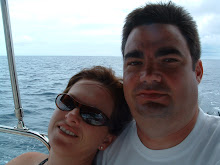We left Samana about 6pm Sunday for the Mona Passage. A brief dolphin escort ensured safe passage. This part of the passage is what all the weather hype is about, being a large area with an hourglass shoal that is 200 feet deep. The surrounding seas are 12,000 feet deep and can cause quite a ruckus when they collide with the shoal. We did not experience any of that. Seas were calm at 4 feet and winds were light at 10 knots. We motorsailed all night Sunday, and all day Monday. We did not anticipate arrival to Boqeron, Puerto Rico until very late Monday night(midnight). Safely over the shoal, though, the winds built to 15-20 knots, 60 degrees off our beam. Saddle up, it’s time to ride!! We screamed across Puerto Rican waters and had the anchor set by 7pm. My friends from Grapevine, Donn and Kitty King of S/V Falcon, were waiting for us and quickly arrived on the scene with a fresh bottle of rum for thirsty and tired sailors.
S/V Pacific Quest under way


Crossing the Mona Passage


Believe it!!

Arrival to Boqueron, Perto Rico





3 comments:
You know- I need to get an old fashioned map and track you guys with pins :)... i find myself getting antsy when there isn't a post from your next fabulous port of call !
Not sure what your sailing plans are around Boquron... but if you make it to the North Side of the island a visit to Arecibo is well worth it. There is a cool little restaurant as you are coming down the mountain from the observatory - something like "Overlook" Christy may recall the name- I'm certain she took a picture when we were there :)
The Arecibo Observatory is located approximately 9 miles south-southwest from Arecibo, Puerto Rico (near the extreme southwestern corner of Arecibo pueblo). It is operated by Cornell University under cooperative agreement with the National Science Foundation. The observatory works as the National Astronomy and Ionosphere Center (NAIC) although both names are officially used to refer to it. NAIC more properly refers to the organization that runs both the observatory and associated labs and offices at Cornell University. The observatory's 305-m radio telescope is the largest single-aperture telescope (cf. ) ever to be constructed. It carries out three major areas of research: radio astronomy, aeronomy (using both the 305-m telescope and the observatory's lidar facility), and radar observations of solar system objects. Usage of the telescope is gained by submitting proposals to an independent board of referees. The telescope is visually distinctive and has been used in the filming of two notable motion pictures: as the villain's antenna in the James Bond movie GoldenEye and as itself in the film Contact. The telescope received additional international recognition in 1999 when it began to collect data for the SETI@home project.
Anxious to hear where your heading next. Steve and I have fond memories of St Vincent and the Grenadines :)
Travel safe and get some rest after your long journey !!
As always- pea green with envy !
karen
I'm with you on the maps, K - I miss the "we are here" maps, Admiral!
Glad you made it safely across the Mona - I remember your earlier post about being bug on a windshield and Daddy had told me that the Mona is like I-95 for BIG ships - yeah, I would definitely have been hanging over the side in those conditions!
8.6 - that is VERY impressive - wish I had been there for that ride!!
Looking forward to your next fabulous post - love ya!
Wow - you are making great time! The pictures are wonderful and it was awesome to see your boat underway.
Keep sending all the wonderful updates!
And yeah - we are going to go get a map and track this journey!!
Love,
Dan and Sue
Post a Comment